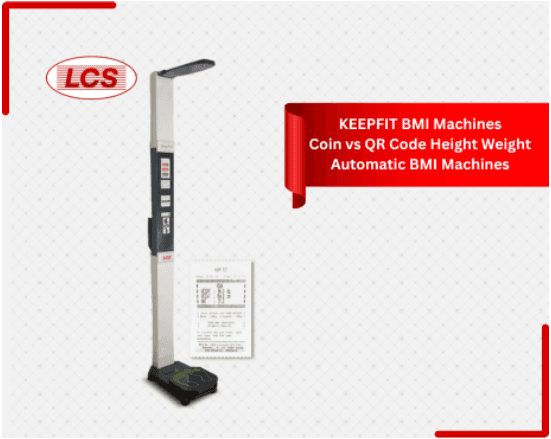Feb 14, 2025
Coin vs QR Code Height Weight Automatic BMI Machines
In the present era of workplace wellness, height-weight automatic BMI (Body Mass Index) machines have become vital for monitoring employee health. As sectors focus on productivity and the welfare of employees, the use of these machines in manufacturing environments is on the rise. It is crucial for manufacturers of BMI machines to comprehend the distinctions between coin-operated and QR code-enabled BMI machines in order to provide products that fulfill the requirements of industrial customers.
This article offers a thorough comparison of the two types, assesses their pros and cons, and provides recommendations to assist manufacturers in aligning their products with market needs.
Height Weight Automatic BMI Machines
Height-weight automatic BMI machines are designed to calculate body mass index by measuring a person’s height and weight. These devices are highly automated, eliminating the need for manual calculations and providing instant results. In industrial environments, they serve as tools for workplace health monitoring, helping employees maintain optimal fitness levels and employers ensure compliance with health and safety standards.
Two primary types of BMI machines are commonly used
Coin-Operated BMI Machines: Require users to insert coins to activate the machine.
QR Code-Enabled BMI Machines: Use a digital interface where users scan a QR code to access the machine's services.
Let’s delve deeper into their functionalities, use cases, and advantages.
Coin-Operated BMI Machines
How They Work
Coin-operated BMI machines require users to insert a specific amount of money to activate the device. Once the payment is made, the machine measures the user’s height and weight, calculates the BMI, and provides a printed or on-screen result.
Advantages
Simplicity of Operation: The process is straightforward, requiring no technical knowledge or smartphone use.
Self-Sustaining Revenue Model: Coin-operated machines generate revenue with every use, making them a viable option for public spaces.
No Internet Dependency: These machines can function independently without requiring internet access or advanced software.
Low Initial Investment: Compared to QR code machines, they often have a lower upfront cost.
Limitations
Limited Data Integration: Coin-operated machines do not store user data.
Cash Handling Issues: Coins can become a maintenance issue due to wear and tear, jams, or limited availability in some regions.
Outdated Appeal: In a world increasingly moving toward cashless transactions, coin-operated machines may seem less modern or user-friendly.
Applications in Manufacturing
Coin-operated BMI machines are suitable for locations with limited access to technology or internet connectivity, such as remote factories or plants. Their revenue-generating potential can be useful in settings where the machine’s use is frequent and self-funded by employees.
QR Code-Enabled BMI Machines
How They Work
QR code BMI machines function by allowing users to scan a QR code using their smartphones. The scanned code typically redirects to a payment gateway or a health app, enabling the user to activate the machine and receive their results digitally.
Advantages
Seamless Digital Integration: QR code machines can connect with health apps, allowing data tracking, analysis, and storage.
Cashless Convenience: These machines eliminate the need for physical currency, offering a modern and user-friendly experience.
Real-Time Data Sharing: Results can be instantly sent to the centralized database for monitoring.
Advanced Features: Many QR code machines offer additional functionalities.
Limitations
Dependency on Internet and Smartphones: These machines require a stable internet connection and user access to smartphones, which may not be available in all manufacturing settings.
Higher Initial Costs: QR code machines often involve a higher initial investment due to their advanced technology.
Maintenance Complexity: Regular software updates and troubleshooting may require technical expertise.
Applications in Manufacturing
BMI machines with QR codes are perfect for smart factories and manufacturing sites that emphasize digitalization. For employers looking to incorporate health data into wider workplace wellness initiatives, these machines are especially advantageous.
Comparative Analysis: Coin vs. QR Code BMI Machines

Key Factors to Consider When Choosing a BMI Machine
Workplace Environment:
For remote or tech-limited locations, coin-operated machines are more practical.
For digitized factories, QR code machines offer better integration with existing systems.
Budget and ROI:
Coin-operated machines have lower upfront costs but generate revenue per use.
QR code machines involve higher investments but provide long-term value through data tracking and health monitoring.
Employee Demographics:
If the workforce is less tech-savvy or lacks smartphones, coin-operated machines are ideal.
For younger, tech-friendly employees, QR code machines enhance user experience.
Health and Safety Programs:
QR code machines support comprehensive health initiatives by storing and analyzing data, which is beneficial for employers focusing on employee wellness.
Maintenance and Longevity:
Coin-operated machines are mechanically simpler but prone to physical damage from coins.
QR code machines require more technical maintenance but offer better durability and scalability.
Recommendations for Manufacturers
BMI machine manufacturers must align their products with the specific needs of industrial clients:
For Remote Factories:
Focus on coin-operated machines with robust designs to handle frequent use and low-maintenance requirements.
Offer customization options, such as adjustable pricing mechanisms.
For Digitized Facilities:
Develop QR code-enabled machines with advanced features like data synchronization, multi-language support, and health insights.
Provide software support and cloud-based data storage solutions.
Hybrid Models:
Consider designing hybrid BMI machines that combine both coin and QR code features. This allows flexibility for industries transitioning to digital platforms.
Customization:
Offer tailored solutions to cater to specific industry demands, such as rugged designs for heavy-duty environments or portable machines for ease of mobility.
Conclusion
The decision to opt for a coin-operated or QR code-enabled automatic height-weight BMI machine should take into account various factors, including the work environment, financial resources, and degree of tech acceptance. Machines that operate with coins are ideal for simple tasks in industrial environments that are either remote or where advanced technology is not commonly used. In contrast, machines that utilize QR codes are designed for contemporary facilities that place a high value on data integration and the health of the workplace.


